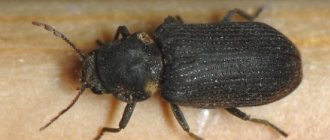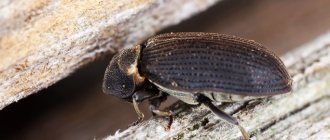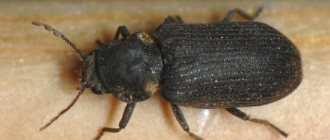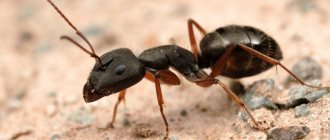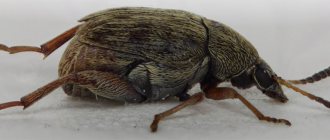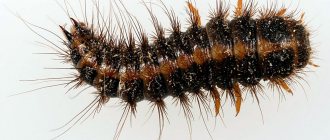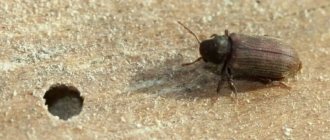Wood tends to be affected by the environment over time: untreated parts of furniture are affected by sunlight, room climate and humidity. One of the unpleasant parasites that worsens the appearance and quality of furniture is the furniture grinder beetle, which can create a lot of problems. In order to overcome an insect in time, you need to understand what it looks like, how it appears and how it is dangerous for humans. Effective methods of combating the parasite will help preserve furniture for many years.
Grinder beetles: what are they?
There are many species of wood-boring beetles in nature, but only a few species can be found at home. These include:
- furniture;
- brownie;
- combed;
- bread
An ordinary furniture woodboring beetle with a body length of 2 to 5 mm, under favorable conditions, is capable of breeding several generations of new offspring in just one year. The insect can be identified by its dark brown color and stripes of dots on the surface of the elytra. Insect larvae reach 6 mm in length. They develop from eggs laid by the female in the most inaccessible dark areas of the furniture. The holes left by the beetle do not exceed 1-2 mm in diameter.
The house tree beetle is identified by its black-brown color with golden dots on its back. The insect reaches 3 mm in length at maturity. The beetle larvae are twice its size. Just like the furniture woodborer, the female house beetle lays eggs in the crevices of mostly coniferous furniture in places with high humidity levels.
The comb grinder reaches 5 mm in length. It feeds mainly on deciduous trees, develops inside the tree, from where it destroys it almost completely, after which it leaves the tree to search for a new source of food.
The bread borer beetle (the photo below will help you not to be mistaken) prefers dry food products and does not disdain food of plant origin.
Separately, it is worth highlighting beetles that are representatives of other families, for example, longhorned beetles and bark beetles. The larvae of the former reach 35 mm in size and gnaw through the surface of wood as close to the surface as possible.
In the photo - a bread grinder
General characteristics of furniture pest
Furniture grinders reproduce by laying eggs. Females drop them into the smallest cracks, recesses, grooves found in wooden products. After 7-14 days, voracious larvae emerge from the eggs, which are capable of sharpening wood, gnawing out a whole network of winding passages and labyrinths in it. If there are a lot of them, then the furniture or wooden floor in the house can turn into dust in almost one season.
Their development lasts from twelve months to several years. After the formation of the pupa, about three weeks must pass for the development cycle to complete with the appearance of the beetle. It chews through the remaining surface of the tree and climbs out. The diameter of the hole reaches several millimeters, but there is more than one pest and the entire wood mass is damaged. The furniture grinder in the photos posted on the site will help you get to know the dangerous pest of all wooden structures more closely.
What are the signs to detect a beetle?
It is not so difficult to discover that a furniture grinder has settled in the house and has managed to hatch larvae in the very depths of the furniture. There are a number of signs by which it is easy to determine the location of the pest. These include:
- monotonous tapping inside the furniture in short series with repetitions, clearly audible and with a unique rhythm;
- holes on furniture with a small diameter;
- traces of insect activity on furniture.
A heavily damaged surface with bugs flying out of it from time to time will indicate a high degree of damage. The absence of holes in the surface of a tree cannot guarantee the absence of pests. The level of infection can be determined at the first sounds emanating from the furniture.
Causes and signs of appearance in the house
Often, after cutting down an area, the wood is stored in this place for a long time. Longhorned beetles waste no time and flock to trees that are no longer able to protect themselves from pests. As a result, they lay eggs in the wood, thereby infecting it. Longhorned beetles appear in the house as a result of using already infested wooden structures.
Therefore, improper storage of felled trees leads to the appearance of these pests, especially if high humidity contributes to this.
The trees cut down are used to build houses, make furniture and other purposes. Over time, larvae emerge from the eggs and begin to make passages in the wood, because of this certain sounds may be heard, similar to rustling or ticking. If these sounds are made during the daytime, this means that the pests are behind the bark. At night, sounds are heard from the activity of the larvae, which are located in the thickness of wooden structures.
You can find out that a tree is infected:
- By the presence of winding passages on the surface of the wood.
- Based on the presence of brown or yellow powder.
- By the appearance of liquid with a sour, pungent odor from the passages of the larvae.
- By how easily the bark is separated from tree trunks.
- By the presence of caterpillars (larvae) in wooden structures.
Longhorned beetle in one of the forest districts of the Oryol region
Watch this video on YouTube
What harm does a grinder do?
Definitely wood bugs in an apartment (the photo will help determine the type of pest) - this is unpleasant, but how dangerous is it for humans? In fact, insects do not pose a serious threat to people, but they cause discomfort primarily through activated activity after dark.
In addition, beetles seriously damage wood, so rooms with an abundance of wooden furniture and natural floors automatically fall into the risk zone. The appearance of uninvited “guests” in the house will lead to serious damage to products and a violation of the integrity of the interior, as a result.
How to find out about the presence of unpleasant insects?
So, let's figure out how to determine whether there are tree beetles in the house (photos of pests are presented in this material):
The first thing you need to pay attention to is the presence of holes. When insects appear on the furniture, small round holes appear, under which lies “drill flour”. If the larvae have climbed far, the entire entrance will be filled with rot.
In this case, a caked mass, or “wormhole,” appears on the wood surface. The darkened sides of the furniture need special attention: it is in these places that holes left by bugs can most often be found.
To find out how seriously the wood is damaged, just pierce it with a screwdriver. If the wood remains hard, you can get by with special treatment. Antiseptic agents, aerosols or pastes will help preserve the wood. Today, the most popular drugs are Antizhuk, Wood Healer, Basilit and Empire-20. Each of these products is applied in an even, not too thick layer so that it does not run off the surface. You can also use motor linseed oil or kerosene. If the screwdriver easily pierces the wood, then it is unlikely that it will be possible to save the damaged areas. And in the future, try not to forget that the fight against wood beetles is a necessary measure to protect wooden structures.
As a rule, insect pests live in passages that they themselves have carved into the tree. During the breeding season, they begin to fly actively and can crawl out onto window sills.
According to reviews and recommendations of experts in the field of wooden house construction, today the best remedy for wood beetles is products. Neomid Antizhuk is considered the most powerful drug against tree beetles.
Folk methods of dealing with grinders - which ones to choose?
At the initial stage of damage to wooden products by insects, you can try to solve the problem using natural remedies and methods. Naturally, it will only be possible to get rid of pests if their appearance is detected before several new generations are born, and the condition of the tree reaches a level where practically nothing can be corrected.
The simplest folk remedies to combat grinders are:
- Table salt solution. It is used to treat contaminated surfaces. The effect can only be achieved indoors.
- An aqueous solution of sodium fluoride or fluoride with a concentration of no more than 2.5%. The composition is prepared simply, use at the rate of 200 ml per m2. A regular paint brush, roller or spray gun is suitable for processing.
- A mixture of naphthalene, resin and black carbolic acid. The components are mixed in equal quantities and the wood is treated with a brush.
- Hot olive. The surface is treated with the compound only when the appearance of the wood no longer matters, and the emphasis is placed on its durability and integrity.
- A solution of turpentine and kerosene (3:1). The mixture is poured into the holes made by pests in the surface of the tree, after lubricating it with Vaseline.
- Kerosene with linseed and motor oils. Wood is processed using brushes and rollers.
When studying folk remedies and methods, you need to remember that bugs appear in furniture for a reason. They are attracted to dampness, which means it is easier to avoid infection by keeping furniture and wooden objects in dry rooms with an optimal microclimate and regular ventilation.
Prevention measures
Protecting building structures from wood-boring beetles is an important measure that will allow these structures to be used for a long time, without fear that they will become unusable. Before processing wood, some measures should be taken. For example:
- Carry out a thorough inspection of the building material, which will determine the presence of the borer beetle in it.
- The bark must be removed from the wood and burned.
- For processing, special antiseptics with complex action are used.
- You need to think about how to further protect the future structure: you may just have to plaster it.
- Rooms with high humidity must be dried regularly using all available means.
- Furniture must be cared for using special products.
Careful inspection of wooden building materials and their subsequent treatment with antiseptics is a guarantee of a long service life of wooden structures. The service life can be increased if such structures are regularly maintained.
wood borer beetle how to get rid of Kirov
How to fight a beetle with insecticides - proven means
If the woodworm has been “harvesting” in the house for a long time and successfully, folk remedies are unlikely to give the expected effect. The solution to the problem at the right level will be proven insecticides. These include drugs in the form of liquid, powder and gel. The latter are not so effective, but products in liquid form really give the desired result due to their ability to penetrate deep into the surface of the tree to drive pests out.
When choosing insecticidal preparations as a control measure, you need to know about some of the features of their use.
Firstly, it is most convenient to apply liquid products to wood using a spray bottle. This is necessary so that the drug penetrates into every, even the most inconspicuous, crack on the surface of the wood. Due to the effect of complete penetration, some insects will die immediately, and the rest will be forced to leave the shelter.
Secondly, you need to remember that insecticides are harmful in most cases to people and pets. This means that if beetles eat wood at home, then surface treatment should be carried out only after all household members and pets have been removed from the house for the duration of the drug.
Thirdly, to achieve the desired result, processing must be thorough. In hard-to-reach places where it is difficult to penetrate without external intervention, it is permissible to drill small holes, which, after exterminating the insects, can simply be sealed with wax or special glue for wood with shavings.
Known remedies against which the furniture beetle cannot resist in most cases, even if the infestation has become widespread, are:
- "Empire-20";
- "Anti-bug";
- "Tree healer";
- "Belinka Belotsid".
Each of the listed products acts for a long time, is actively absorbed into the surface of the tree, literally destroying beetles and preventing their appearance in the future. Before using the drug, it is important to carefully study the instructions. Only that drug is considered useful if there is a note on its packaging that it can be used against flying insects. Only such agents can be used against adults and their larvae.
Do antiseptics work? If insects eat wood at home or in storage areas, then antiseptics, if chosen correctly, can actually act not only as a means of prevention, but also as an active drug. For example, Mark 4 product gives an effect at the initial stage of tree damage. The solution is injected into the holes left by the pest using a miniature oil can or syringe.
If the pest has managed to breed and the surface is more seriously damaged, in addition to douching, the surface is completely treated for reliability, capturing the edges by 500-700 mm. The tree is treated several times every 2-3 days until only traces of its vigorous activity remain on the surface of the pest.
Protecting a building from bark beetle at the construction stage - is it possible?
How to deal with a grinder in a wooden house? This is a complex process, so experts recommend preventing infection during the construction phase.
- When purchasing material, it is necessary to audit it. Oval holes will be a sign of the presence of a tree bark beetle.
- Logs and poles must be sanded. The removed bark is burned.
- Wooden elements must be treated with impregnations. This helps fight bark beetles before they appear.
How to treat wood and what products can be used, you will learn from the table below.
| Product brand | Spectrum of influence | Description of the effect of using the drug |
| Empire-20 | wide | up to 90 days, not removed, resistant to temperature and UV influences |
| NEOMID Stop Beetle | wide | Recommended twice treatment with a break of 14 days, absorbed without problems |
| Tree healer | wide | Brand 1 is used for prevention, Brand 4 is used for baiting tree bark beetles, it will require double treatment with an interval of 3 days |
| Antishashelin | woodworms | effective when poured into flight holes, resistant to moisture and light |
| Senezh | wide | up to 30 years, practically not washed out, suppresses the development of fungi, gives the material a greenish tint |
| Polyex "Woodpecker" | woodworms | requires three-time treatment with a break of 3 hours, is not resistant to atmospheric influences, cannot be used in baths and saunas |
For external work it is allowed to use waste machine oil.
Fumigation - when is it necessary and how is it carried out?
If there are tree beetles in a house or wooden building, and their numbers have increased so much that none of the listed remedies help, you can try to fumigate the area with insect-infested surfaces.
Fumigation is a method of controlling harmful insects using special aerosols or smoke containing fumigants. It would be appropriate to use magnesium or aluminum phosphide.
Before starting the procedure, it is mandatory to remove all pets from the premises, and also free it from family members. Food, dishes, toys, and clothes are carefully covered with film. Windows, doors and vents are tightly closed.
The smoking process will take several weeks on average, but will depend on the room temperature. After completing the procedure, wet cleaning is carried out using a solution of soda ash.
Considering that fumigation is carried out by trained employees of a special service and requires so much time, it makes sense to seek help only if the bugs cannot be exterminated and continue to annoy. It is also important that residents of a house or apartment where woodworms have infested have the opportunity to leave their home for the required period.
Characteristics
The effectiveness of the fight against the pest depends on how quickly traces of the presence of the pest in the house can be identified. Studying the characteristics of its appearance and behavior will help you do this.
Appearance
The grinder beetle, the photo of which is located below, is a miniature and rather inconspicuous insect. Its length is only about 3 mm, so without magnifying tools it is very difficult to see the subtleties of the structure of this beetle, as well as simply detect it. If you use a microscope, you can see fine silky hairs on the insect’s body.
The body of the beetle has a fairly massive and wide front part (pronotum), fused with the head. In its shape it resembles a hood - and this is the main distinguishing feature of the insect. The second characteristic feature is ten deep grooves on the elytra. The color of the body is brownish-brown, and the matte chitin covering it is not bright and does not attract attention.
Reproduction
Grinder beetles reproduce by oviposition: when favorable temperatures occur, the female lays a large number of eggs in holes in the wood. After 1-2 weeks, white larvae emerge from them, which immediately begin to gnaw holes in the tree, causing damage to it. Traces of their presence are revealed by the yellow pollen that appears in the places where they are located.
The larva develops for quite a long time - 1-2 years. After this, it transforms into a pupa, which very soon should become an adult beetle. As a larva, the pest gnaws out a “burrow”, the length of which is equal to the thickness of the wood. Having turned into an adult insect, the beetle wears out the part that remains and then comes out.
Usually the diameter of the hole through which it comes out is only a few millimeters. But since there are usually a lot of bugs, most of the wooden structure after their “work” becomes hollow and can break from light pressure.
Habitats
You can meet the grinder beetle everywhere except in permafrost areas. According to scientists, this species has existed for thousands of years, and it is no coincidence that humans are very familiar with it. Previously, there was no particular fight against the furniture beetle - it was equated with such permanent inhabitants of the home as crickets. The grinder does not depend on climatic conditions, since it constantly lives in houses, and even inside wooden structures. Therefore, it multiplies non-stop, without winter pauses.
Varieties
Depending on the type of wood beetle, the damage caused to your home varies. Among the huge variety of pests, we have selected the most typical pests that can most often be found in our homes.
House grinder
This wood beetle is distinguished by the fact that it feeds primarily on moistened wood. Therefore, it is practically never found inside houses. Most often it damages the outer walls of log houses, bathhouses, and other structures.
The length of the tree beetle's body is only 2.5-3 millimeters.
Furniture sharpener
But this enemy is already more dangerous; it damages wood in dry rooms, that is, inside our houses and apartments. As the name implies, it not only feeds on the walls of wooden houses, but also devours furniture. These beetles attack picture frames, spines and pages of books, and many other things that are based on cellulose.
Since this bug is the most dangerous for our everyday life, let us dwell on its description in more detail. The color of the chitinous cover of this beetle is dark brown, the body length can reach up to five millimeters. At the same time, it is almost impossible to see these insects; they are very shy and hide in the darkest and most inaccessible corners of the building.
The larvae are also not visible from the outside, since the beetles make very few moves, and the larva hatched from the egg leaves the solid wood only after its complete destruction. Mating of individuals also occurs in the thickness of the wood.
And yet, you can determine if this insidious enemy is in the apartment by several signs:
- The characteristic ticking of the “death clock”. If you hear a strange clock in the house, this is a characteristic sign of the presence of a grinder.
- The presence of neat holes with a diameter of 2-3 millimeters on wooden furniture or walls. These holes are gnawed by the bugs to get out.
- Detection of wood beetles indoors.
The lifespan of the furniture grinder ranges from 1 to 3-4 years, depending on the duration of the larval development stage. Biologists have divided the entire life of a bug into the following periods from the moment the female lays eggs:
- Egg development lasts from one to three weeks.
- The growth of the larvae at a favorable temperature, which is 26-29 degrees Celsius, lasts three weeks. At low temperatures, a winter pause in development may occur, and this period can be up to three years.
- The larva pupates and spends two weeks in this state.
- The beetle itself does not live long either. His sentence is only two to four weeks.
It should be noted that a species can only be generated twice in a year. Under the most optimal conditions, when there is a warm spring, beetles lay eggs for the first time. New beetles will appear only in the fall, and if conditions are favorable, then by the beginning of winter they will be able to produce the second offspring of the year. But this happens extremely rarely.
Common comb grinder
This beetle differs from its fellows by its unusual mustache, for which, in fact, it got its name. The length of its body is usually within 3-5 millimeters. Having penetrated into the thickness of the tree, this beetle sometimes does not emerge from it until it is completely destroyed.
Bread grinder
The next type of grinder is a bread grinder. This beetle, among others, is somewhat selective in food. He won’t just eat a tree, give him grain, cereals, pasta or dried fruits. In general, it is also a dangerous pest, but it strikes from the other flank.
Preventive measures
The best way to fix a problem is to eliminate its causes. The appearance of a grinder is a very dangerous signal. He talks not only about the threat to house structures and buildings, but also about the possibility of damage to garden plants. Therefore, it is necessary to cut off all ways of insects entering the area.
Most often they come from lumber brought from an infected sawmill or trading base.
To protect against the grinder, you should inspect the material, paying special attention to defective areas of the boards (presence of bark, dead parts). If affected boards or timber are found, it is recommended to refuse the purchase and look elsewhere. What products do you use to deal with the beetle grinder?
What products do you use to deal with the beetle grinder?
FolkChemical
Experts say that completely eliminating the borer is extremely difficult, if possible at all. Therefore, the processing procedure should be repeated periodically. If possible, affected structural elements should be replaced with new, clean parts. This will prevent the spread of insects and damage to garden plants.
The appearance of a beetle grinder cannot be detected immediately. Therefore, it is necessary to take action immediately. It is unknown how far the insects have spread inside wooden parts or structures, or how many trees they have managed to inhabit.
It is recommended to immediately carry out a thorough inspection, examine the most critical areas and carry out treatment. If you have no experience, the best solution would be to contact a specialized company or SES. The participation of specialists will help solve the problem in the most effective way.
